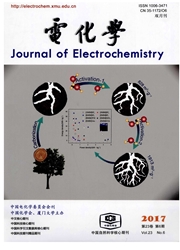

 中文摘要:
中文摘要:
利用基于平面波的密度泛函理论(DFT)计算研究了氧气分子在Pt(111)表面的吸附和解离,以及解离产物进一步质子化形成H2O的过程.通过使用不同尺寸的平板模型和在表面预吸附不同数量的氧原子,研究了氧覆盖度对氧还原反应(ORR)路径的影响,并对使用不同水合质子模型的计算结果进行了比较.研究结果表明:质子化的end-on化学吸附态OOH*的形成是ORR的初始步骤;OOH*能够转化形成非质子化的top-bridge-top化学吸附态O2*,或者解离形成吸附的O*物种.对不同氧覆盖度下各种可能步骤的活化能计算结果表明,O*的质子化形成OH*物种是ORR的速决步骤.增加氧覆盖度时,该步骤的活化能减少.此外,还发现使用比H7O3+更复杂的水合质子模型不会改变计算所得的反应路径.
 英文摘要:
英文摘要:
DFT calculation is used to study various possible steps in the oxygen reduction reaction(ORR),including the adsorption and dissociation process of O2 and the serial protonation process of dissociated products to form H2O on the Pt(111) surface.By using slabs of different sizes,and different numbers of pre-adsorbed oxygen atoms,the coverage effects on the pathways are investigated.The calculated results using different hydrated proton models are also compared.It is shown that the initial step of the ORR is the formation of a protonated end-on chemisorbed state of OOH*,which can transform to an unprotonated top-bridge-top state of O2* or dissociate into adsorbed O* species with similar activation barrier.The calculated activation barriers for various possible steps at different oxygen coverages suggest that the protonation of O* to form OH* species is the rate-determining step in the ORR.With the increased oxygen coverage,the activation energy of this step decreases.It is found that the use of hydrated proton models more complicated than H7O3+ does not change the calculated pathways.
 同期刊论文项目
同期刊论文项目
 同项目期刊论文
同项目期刊论文
 期刊信息
期刊信息
